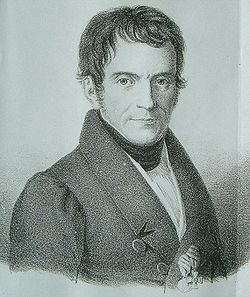Johann Georg Heine
| Johann Georg Heine | |
|---|---|

The German orthopedist Johann Georg Heine
|
|
| Born |
April 3, 1771 Lauterbach, Habsburg Empire (in present-day Germany) |
| Died | September 7, 1838 (aged 67) Scheveningen, The Netherlands |
Johann Georg Heine (April 3, 1771 – September 7, 1838) was a German orthopedic mechanic and physician. He is considered the father of Orthopedics in Germany.
Heine was born in Lauterbach on April 3, 1771, the son of a brewer. He was apprenticed to a cutler at Überlingen and worked as a journeyman cutler in Esslingen am Neckar, Mannheim and Straßburg. At length he left Southern Germany and took his residence in Berlin from 1794 to 1798, where he got into contact with Barthel von Siebold, a son of a Würzburg surgeon Karl Kaspar von Siebold. In May 1798 Heine moved to Würzburg and became a craftsman making medical instruments for the Würzburg University. He married Anna Förtsch from Würzburg and had two children, Anna (born 1801), who later married her cousin Bernhard Heine, and Joseph Heine (born 1803), who was to become an important physician in the Electorate of the Palatinate.
Soon Heine had his own workshop where he manufactured artificial limbs, stretching beds, wheelchairs and other orthopedic appliances and offered them for sale. In 1807 Heine published his Systematic Index of surgery instruments, bandages and machines, a kind of catalogue for physicians, with later editions in 1811 and 1827. His subsequent publications soon met with recognition among medical experts. He declined an offer to work in Berlin and stayed in Würzburg.The Bavarian crown prince awarded him an order for his merits ("Goldene Zivil-Dienst-Medaille") and even Johann Wolfgang von Goethe knew Heine's publications and included them in his library. He got to know "Operateur Heine" at the dinner table of Grand Duke Karl August and invited him to his private home.
...
Wikipedia
